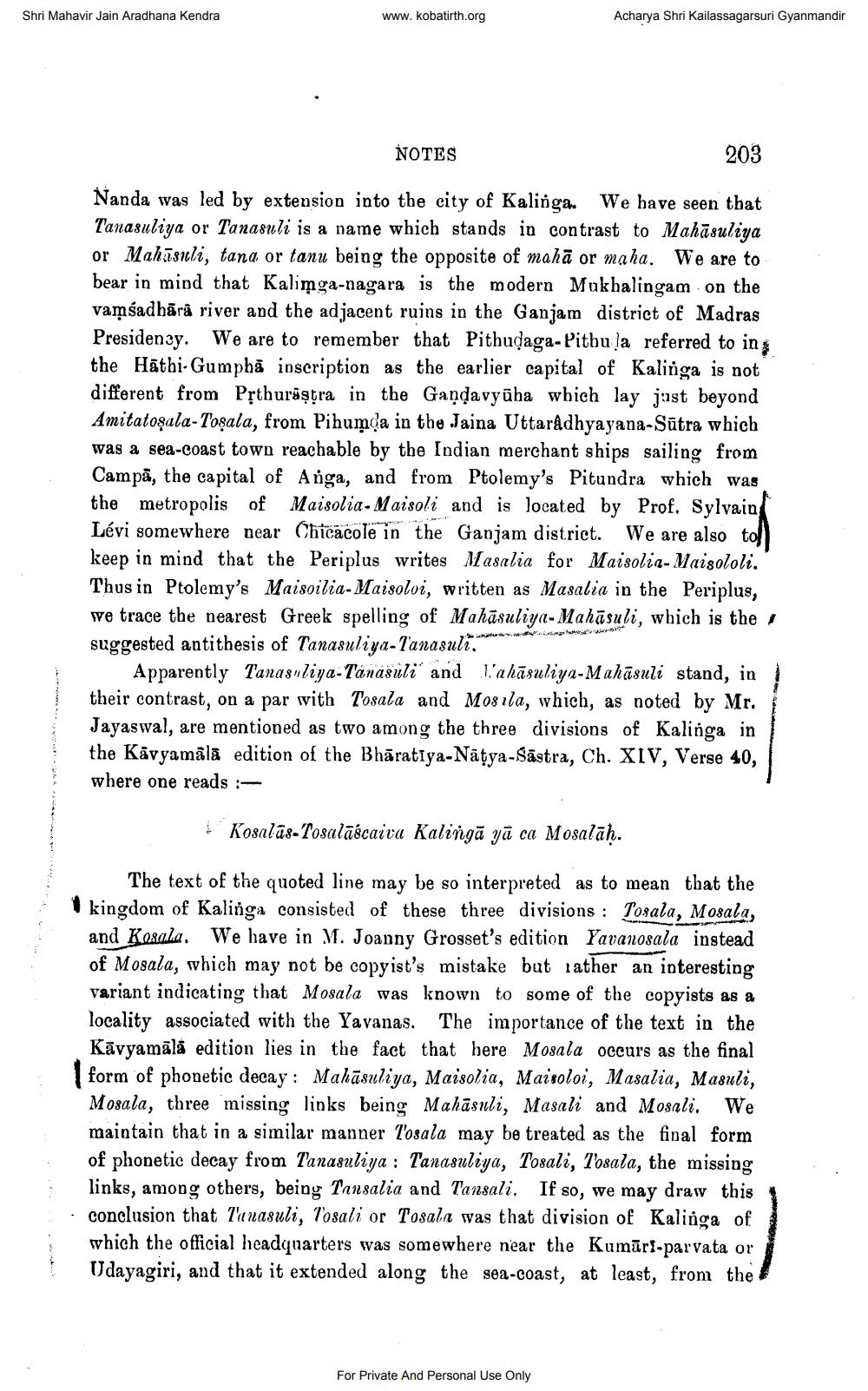________________
Shri Mahavir Jain Aradhana Kendra
www.kobatirth.org
Acharya Shri Kailassagarsuri Gyanmandir
NOTES
203
Nanda was led by extension into the city of Kalinga. We have seen that Tanasuliya or Tanasuli is a name which stands in contrast to Mahāsuliya or Mahāsuli, tana or tanu being the opposite of mahā or maha. We are to bear in mind that Kalimga-nagara is the modern Mukhalingam
the modern Mukhalingam on the vaņsadhārå river and the adjacent ruins in the Ganjam district of Madras Presidenzy. We are to remember that Pithuờaga-Pitbula referred to ing the Hathi-Gumphà inscription as the earlier capital of Kalinga is not different from Pșthurāṣtra in the Ganda vyūha which lay just beyond Amitatoşala- Toşala, from Pihumda in the Jaina Uttaradhyayana-Sūtra which was a sea-coast town reachable by the Indian merchant ships sailing from Campā, the capital of Anga, and from Ptolemy's Pitundra which was the metropolis of Maisolia-Maisoli and is located by Prof. Sylvain Lévi somewhere near Chicacole in the Ganjam district. We are also to keep in mind that the Periplus writes Masalia for Maisolia-Maisololi. Thus in Ptolemy's Maisoilia-Maisoloi, written as Masalia in the Periplus, we trace the nearest Greek spelling of Mahāsuliya- Mahāsuli, which is the suggested antithesis of Tanasuliya-Tanasuli.
Apparently Tanasıliya-Tanasuli and l'ahāsuliya- Mahāsuli stand, in their contrast, on a par with Tosala and Mosila, which, as noted by Mr. Jayaswal, are mentioned as two among the three divisions of Kalinga in the Kāvyamāla edition of the Bhāratiya-Nāțya-Sāstra, Ch. XIV, Verse 40, where one reads :
Kosalās-Tosalāscaiva Kalinga yā ca Mosalāḥ.
The text of the quoted line may be so interpreted as to mean that the 1 kingdom of Kalinga consisted of these three divisions : Tosala, Mosala,
and_Kesala. We have in M. Joanny Grosset's edition Yavanosala instead of Mosala, which may not be copyist's mistake but ather an interesting variant indicating that Mosala was known to some of the copyists as a locality associated with the Yavanas. The importance of the text in the Kāvyamālá edition lies in the fact that here Mosala occurs as the final | form of phonetic decay: Mahāsuliya, Maisolia, Maisoloi, Masalia, Masuli,
Mosala, three 'missing links being Mahāsuli, Masali and Mosali. We maintain that in a similar manner Tosala may be treated as the final form of phonetic decay from Tanasuliya : Tanasuliya, Tosali, Tosala, the missing
links, among others, beiny Tansalia and Tansali. If so, we may draw this · conclusion that Tunasuli, Tosali or Tosala was that division of Kalinga of
which the official headquarters was somewhere near the Kumārl-parvata or Udayagiri, and that it extended along the sea-coast, at least, from the
For Private And Personal Use Only




